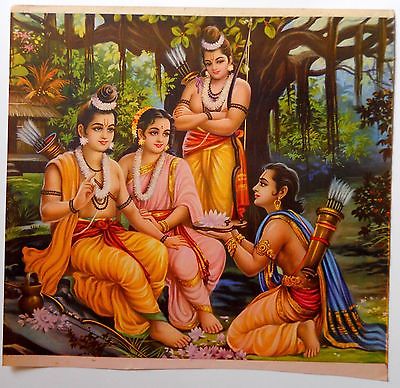Ayodhya Kanda
Contents
Ayodhya Kanda (the book of Ayodhya) is the second book of the Valmiki Ramayana, which is one of the two great epics of India (the other being the Mahabharata).
The book consists of 119 sargas (sometimes translated as chapters or "cantos") of Sanskrit verse.
Dasaratha’s decision to install Sri Rama
Sri Rama was ever receiving praises from the citizens of Ayodhya as well as learned people, including the ministers. The ageing King Dasaratha therefore decided to install him as his successor. Preparations were made for a grand and splendid inaugural ceremony.
Manthara poisons Kaikeyi’s mind
When the gods realised that the coronation was not going to serve their ends (for Lord Vishnu had incarnated as Sri Rama in order to put an end to Ravana who was a menace to both humans and gods), they approached Mother Sarasvati to obstruct the installation of Sri Rama. Mother Sarasvati perverted the mind and and speech organ of Manthara, the hump-backed maidservant of Kaikeyi. Kaikeyi was overjoyed to hear that Sri Rama would be crowned yuvraja the following day. But as Manthara addressed her, her mind slowly changed. Manthara made her believe that the inauguration would place her in an inferior position and that Bharata would be banished or killed. Consequently, she asked the king for the two boons he had once offered her: firstly, that Bharata should be installed as yuvraja, and secondly, that Sri Rama be banished to the forest for fourteen years. It is only much later that Kaikeyi regains normalcy, and deeply repents her actions.
The Banishment
The helpless king was shocked at Kaikeyi’s requests but was forced to give in. When Sri Rama discovered the cause of his father’s sorrow, he was not moved by the change in his own fortune but accepted his father’s reluctant decree with absolute calmness. He was joined by the angry Lakshmana and devoted Mother Sita who said, “The forest where you dwell is Ayodhya for me, and Ayodhya without you is a veritable hell for me.”
The Boatman Episode
Guha, a Nishada chieftain, met Sri Rama and paid homage to him. The Lord embraced him, but could not accept his hospitality as he was under the vow not to enter a town.The simple-minded boatman would not let Sri Rama enter his boat without his washing his feet. He had heard that the touch of the Lord’s foot had converted a stone into a beautiful woman – he did not want his means of livelihood turned into a woman!
Bharata rejects his Mother
Unable to bear the grief of separation, King Dasaratha passed away. Bharata returned from his uncle’s home and when he learnt about the tragic events, he railed against his scheming mother and refused to accept the kingdom. He at once set out to meet Sri Rama, determined to bring him back.
Bharata meets Sri Rama
Although Bharata tried in various ways to coerce Sri Rama to return to Ayodhya as king, the lord was insistent on keeping his promise. Bharata returned, carrying Sri Rama’s sandals which he placed on the throne. He ruled as Sri Rama’s regent from Nandigrama, a little village away from the city.
Click on the link below for the Kananda translation of Ayodhyakanda of Shrimadvalmiki Ramayana with the original Sanskrit Shlokas, translated by N. Ranganatha Sharma (the scanned copies were kindly provided by Shri Krishna Rao Srinivasa Rao):
- Valmiki Ramayana_Ayodhyakanda Purvardha_Kannada translation with Original Shlokas
- Valmiki Ramayana_Ayodhyakanda Uttarardha_Kannada translation with Original Shlokas
